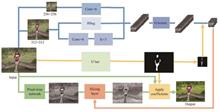This paper addresses the issue of hazy stray light in fundus retinal images, which leads to unclear blood vessel details. The proposed dehazing algorithm for fundus retinal images is based on the dark channel theory and incorporates Gamma transformation. The algorithm enhances the clarity of the image while preserving blood vessel information. This algorithm aims to defog images by processing the R, G and B channels separately. Firstly, the algorithm calculates the dark channel image using adaptive window minimum filtering and takes the average value of the top 0.1% pixels as the atmospheric illumination intensity value. Secondly, the algorithm solves the rough transmittance of the image and improves it using the guided filtering algorithm. Finally, the algorithm restores the haze-free image using the atmospheric scattering model and applies Gamma transformation. The experimental results show that the information entropy and average gradient of the restored image increase by an average of about 6.8% and 11.6%, respectively. The algorithm in this paper can quickly and effectively remove hazy stray light in the fundus retinal image, restore the image to be clear and natural, and retain the details information of retinal blood vessels.
Deep learning based high dynamic range (HDR) image processing algorithms has the problem of skin color deviation when processing images containing human figures. In response to this issue, this article proposes a portrait HDR image processing algorithm based on multi feature fusion-U2HDRnet. This algorithm consists of three parts: skin feature extraction module, trilateral feature extraction module and color reconstruction module. Firstly, the skin feature extraction module separates the color and position information of the skin region. Secondly, the trilateral feature extraction module extracts local features, global features and semantic features of the image, and fuses them with skin features. Finally, the color reconstruction module interpolates the grid in terms of space and color depth. In addition, this article adds an improved fusion module of self attention and convolution to improve the processing performance of HDR. At the same time, this article also produces the PortraitHDR dataset for portraits, filling the gap in the dataset in this field. The test results show that the PSNR of U2HDRnet reaches 31.42 dB, and the SSIM reaches 0.985, both of which are superior to the commonly used HDR algorithms. They obtain high-quality portrait HDR images while avoiding skin distortion.








